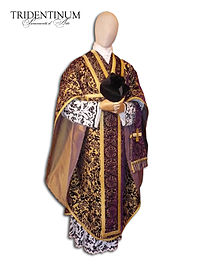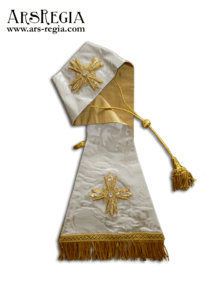- Maniple (vestment)
-
- For the Roman military unit, see Maniple (military unit).
The maniple is a liturgical vestment used primarily within the Catholic Church, and occasionally used by some Anglo-Catholic and Lutheran clergy. It is an embroidered band of silk or similar fabric that when worn hangs from the left arm. It is only used within the context of the Mass, and it is of the same liturgical colour as the other Mass vestments.[1]
Contents
Current use
In its 1967 instruction, Tres Abhinc Annos, the Roman Catholic Church's Sacred Congregation of Rites effectively removed the obligation to use the maniple during the liturgy. The document states:
"The maniple is no longer required".[2]
After this Instruction, the vestment fell out of liturgical use.
Some claim that the use of the maniple in the Roman Rite (even in the liturgy as revised under Pope Paul VI) has never been formally abolished or suppressed by the Catholic Church. Priest and blogger, the Rev. John Zuhlsdorf [3]), for example, cites comments made by Fr. Mauro Gagliardi, consultor to the Vatican's Office of Pontifical Ceremonies, who said during a ZENIT interview:
"The maniple is an article of liturgical dress used in the celebration of the extraordinary form of the Holy Mass of the Roman Rite. It fell into disuse in the years of the post-conciliar reform, even though it was never abrogated."[4]
This interpretation hinges on the fact that the Sacred Congregation of Rites only declared above that the vestment was no longer required for the celebration of Mass, rather than saying its use was suppressed.
Arguing against this view is the fact that after the SCR's Instruction the maniple—even as an optional vestment—was completely omitted from subsequent editions of the Catholic Church's Roman Missal, the book used by priests to celebrate Mass.[5] This is an interesting omission given that another vestment whose use is also no longer required, viz. the amice, is still specifically mentioned (see GIRM, no. 119).
Further, this interpretation is challenged by the Rev. Edward McNamara, a Professor of Liturgy at Regina Apostolorum University as well as writer for the same ZENIT News Service. Responding to a question about using the maniple during the revised Mass, McNamara writes:
"Another reader asked about some vestments no longer in use: I noticed one who had offered the new rite but wore the maniple. . . . The rationale was that the maniple had not been suppressed, but simply that it was no longer required. I do not think that the rationale justifying the use of the maniple . . . is correct. It is not necessary for the Holy See to issue a decree abolishing every single detail. When . . . the legislator lists the vestments to be worn, then logically any further additions no longer correspond to the norms."[6]
The maniple is still required for the celebration of the 1962 Missale Romanum in accordance with the 2007 motu proprio Summorum Pontificum.[citation needed]
Usage
When used, the maniple is worn by a priest only when vested in a chasuble for celebrating Mass. A bishop celebrating a (Tridentine) Low Mass assumes the maniple only after the Prayers at the Foot of the Altar. The 1960 Code of Rubrics, incorporated into the 1962 Roman Missal, states that the maniple is never worn with the cope (as, for instance, in the Asperges ceremony or in giving Benediction of the Blessed Sacrament); and, if no cope is available, it allows the priest to give such blessings vested in an alb and wearing a stole, but without chasuble and maniple.[7]
The maniple is worn also, with the dalmatic or tunicle, by the deacon and the subdeacon in a Solemn Mass.
The maniple is a vestment not only of the Roman Rite, but also of most of the other Latin liturgical rites.
With regard to what is now the normal form of the Roman Rite, as revised in 1969, the General Instruction of the Roman Missal states: "The vestment proper to the priest celebrant at Mass and other sacred actions directly connected with Mass is, unless otherwise indicated, the chasuble, worn over the alb and stole."[8] For the deacon it says: "The vestment proper to the deacon is the dalmatic, worn over the alb and stole. The dalmatic may, however, be omitted out of necessity or on account of a lesser degree of solemnity."[9] In neither case is there any mention of the maniple as a vestment in use.
Historical origin
Originally the maniple was likely a piece of linen which clerics used to wipe their faces and hands and has been described by some modern commentators as being akin to a handkerchief. It appears to have been used in the Roman liturgy since at least the 6th century. The maniple can vary widely in size, shape, and degree of embroidery and ornamentation.
Common symbolic comments refer to the maniple's likeness to the rope by which Christ was led and the chains which bound his hands. It has also become known as an emblem of the tears of penance, the burden of sin, and the fatigue of the priestly office. This understanding is reflected in the vesting prayer said while putting on the maniple before Mass. Anglican commentators have described the maniple as a symbol of being a servant to the servants of God.
In the unreformed Papal Mass the Pope wears a special maniple intertwined with red and gold threads, symbolizing the unity of the Eastern and Western rites of the Catholic Church.
See also
References
- ^
 "Maniple". Catholic Encyclopedia. New York: Robert Appleton Company. 1913.
"Maniple". Catholic Encyclopedia. New York: Robert Appleton Company. 1913. - ^ Sacred Congregation of Rites, Tres abhinc annos, no. 25
- ^ "ALERT! Maniples in the news! | Fr. Z's Blog – What Does The Prayer Really Say?". Wdtprs.com. 2009-12-19. http://wdtprs.com/blog/2009/12/alert-maniples-in-the-news/. Retrieved 2011-09-19.
- ^ Mauro Gagliardi, ["Liturgical Vestments and the Vesting Prayers," http://www.zenit.org/rssenglish-27878]
- ^ See Ch. VI, "Requisites for the Celebration of Mass" (nos. 335-47)General Instruction of the Roman Missal (GIRM)
- ^ "Use of Altars by Non-Catholics". ZENIT. 2006-02-07. http://www.zenit.org/article-15218?l=english. Retrieved 2011-09-19.
- ^ Code of Rubrics, 136
- ^ General Instruction of the Roman Missal, 337
- ^ General Instruction of the Roman Missal, 338
Categories:- Eucharistic vestments
- Papal vestments
- Anglican vestments
- Lutheran vestments
- Roman Catholic vestments
Wikimedia Foundation. 2010.


